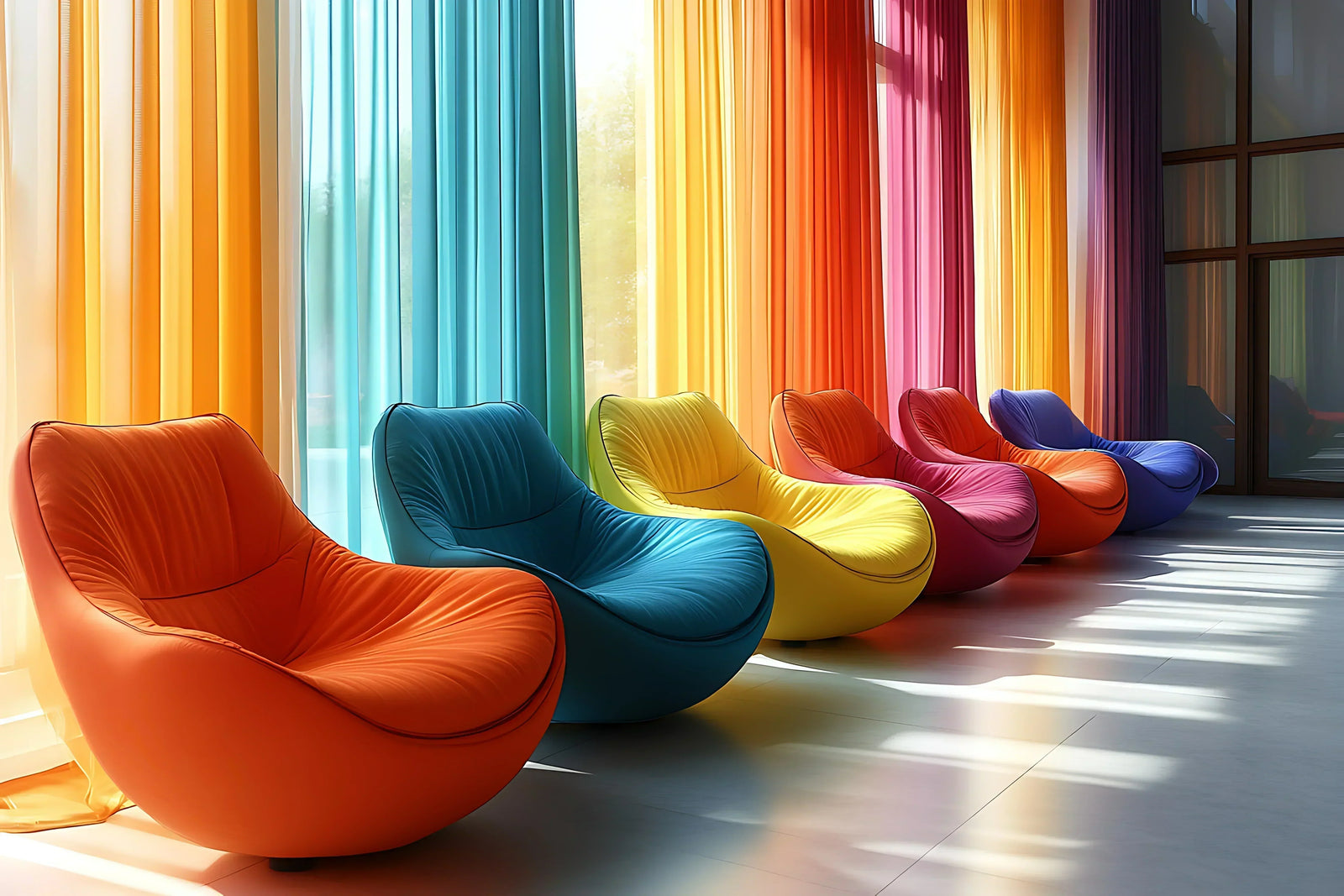Our work environment profoundly affects our mood, productivity, and even how we interact with others. Among all design elements, color is one of the most powerful — and yet one of the most underestimated.
Today, more and more companies, designers, and ergonomics specialists recognize the impact of color psychology when designing modern workplaces. The right color palette can help reduce stress, improve focus, and spark creativity. The wrong one can lead to fatigue, tension, and lower motivation.
In this article, we’ll explore how colors affect the brain, which tones are best for focus and relaxation, and how to integrate them effectively into your workspace design.
The Psychology of Color: How the Brain Reacts to Its Environment
Every color evokes an emotional or physical response. The human brain instinctively associates certain hues with specific feelings — blue with calmness, red with energy, green with balance. These associations are deeply rooted in our perception and influence our behavior daily.
Why Colors Affect Work Performance
Environmental psychology studies show that color can:
- Influence heart rate and stress levels.
- Change the perception of space and time.
- Help maintain focus or stimulate creativity.
- Affect mood and motivation.
In short, color isn’t just about aesthetics — it’s a strategic tool for well-being and performance.
The Best Colors to Boost Focus and Productivity
Some shades are ideal for focus, structure, and deep thinking. They work best in individual workstations, private offices, or any area that requires concentration.
Blue: The Color of Productivity and Logic
Blue is widely recognized as the most effective color for mental focus. It conveys trust, calm, and reliability — no surprise it’s a favorite in industries like tech, finance, and engineering.
💡 Design tip: choose soft tones such as sky blue or blue-grey to avoid a cold feeling, and pair them with light wood or natural materials to bring warmth.

Soft Gray: Minimalism That Keeps the Mind Clear
Light gray provides a neutral background that limits visual distractions. It fits perfectly in minimalist or modern offices. Avoid dark or metallic grays, which can make the space feel impersonal or heavy.
Green: Balance and Mental Endurance
Green symbolizes growth, nature, and stability. It’s proven to reduce visual fatigue and support long-term concentration, making it a great choice for long working hours.
💡 Design tip: use green as an accent — a painted wall, plants, lounge chairs or accessories are often enough.
Colors That Reduce Stress and Promote Well-Being
Modern companies now design offices that reduce stress and support mental health. Color plays a key role in creating such balanced environments.
Beige and Earth Tones: Warmth and Grounding
Natural tones evoke comfort and security. They’re ideal for lounges, rest zones, or meeting areas where people need to recharge.
Combine them with wood, linen, or clay finishes to create a natural, cozy look.
Sage Green and Pastel Shades: Softness and Calm
Soft tones like sage green, powder blue, or blush pink help reduce tension and create a soothing atmosphere. They diffuse light beautifully and make spaces feel more peaceful and human.
Off-White: Clarity Without Harshness
Unlike pure white, off-white (ivory or cream) feels softer and less sterile. It enhances brightness while keeping the mood calm and focused. Perfect for shared offices or open spaces — just balance it with some colorful or textured elements to avoid monotony.
Energizing Colors for Creativity and Collaboration
Creative spaces need energy and stimulation. Certain hues encourage conversation, idea-sharing, and innovative thinking.
Yellow: Creativity and Optimism
Yellow represents intelligence, light, and energy. It boosts confidence and optimism, making it perfect for brainstorming zones.
Use it moderately, as too much yellow can cause fatigue or restlessness.
💡 Design tip: a mustard-yellow accent wall or decorative details (artwork, chairs, lamps) can instantly brighten a space.
Orange: Energy and Team Spirit
Orange sparks enthusiasm and communication. It’s ideal for cafeterias, meeting rooms, or informal collaboration zones.
Avoid overuse — too much can feel overwhelming.
Red: Powerful but Intense
Red stimulates the nervous system and draws attention — useful for dynamic spaces or brand accents. However, in large doses, it may increase tension or stress. Use it sparingly, for example in decor items or signage.
How to Choose the Right Colors for Your Office
1. Define the Purpose of Each Area
Every area serves a different goal — focus, relaxation, or teamwork. Match the colors accordingly:
- Private offices → blue, soft gray, green.
- Meeting rooms → yellow, orange, light wood.
- Break areas → beige, sage green, off-white.
2. Consider Natural Light
Lighting changes how colors look:
- In darker spaces, use warm or light tones.
- In bright, sunlit spaces, cooler tones or matte finishes will balance the environment.
3. Match Colors with Office Furniture
Wall colors should complement your furniture. At Solutions M3, we offer ergonomic chairs and adjustable desks in neutral and natural finishes that integrate seamlessly into any color scheme.
When color and furniture work together, the result is both visually pleasing and emotionally balanced.
4. Use Accents and Textures

You don’t have to repaint the entire office. Add color through:
- Accessories (rugs, artwork, lighting).
- Acoustic panels or partitions.
- Office chairs or decorative objects.
This layered approach adds personality and depth without overwhelming the space.
Color Trends in Modern Workspaces
Contemporary offices are increasingly inspired by biophilic design — connecting people with nature through materials and colors.
The most popular workplace color trends for 2025 include:
- Sage and eucalyptus green for calm and balance.
- Slate and misty blue for focus.
- Beige and terracotta for warmth and comfort.
- Ochre and clay for creativity and collaboration.
These palettes promote a more human, sustainable, and emotionally intelligent work environment — in tune with the values of today’s organizations.
In Summary: Color as a Productivity and Wellness Tool
Colors shape our emotions, focus, and motivation. Choosing the right palette means improving both well-being and performance.
A thoughtful color strategy is more than decoration — it’s a cornerstone of successful workplace design.
At Solutions M3, we help businesses design ergonomic and inspiring workspaces, where color, furniture, and light come together to create environments where people truly thrive.
FAQ – Office Color Psychology
-
Q1. What’s the best color to improve focus at work?
-
Blue is widely considered the best color for focus and mental clarity while reducing stress.
-
Q2. Which colors should I avoid in an office?
-
Avoid overly bright reds, dominant blacks, or highly saturated colors that can cause visual fatigue.
-
Q3. How can I add color without repainting the whole office?
-
Use colored chairs, wall panels, plants, or accessories to introduce vibrancy subtly.
-
Q4. Does green really improve productivity?
-
Yes — green evokes nature and balance, helping to lower stress and maintain long-term focus.
-
Q5. Should I stick to one color or mix several?
-
Use two to three complementary tones: a neutral base, a calming color, and a lively accent.
-
Q6. How can color reflect my company’s culture?
-
Choose colors aligned with your values — blue for trust, green for sustainability, yellow for creativity, etc.


